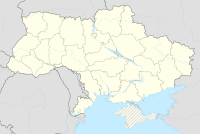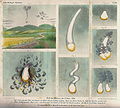Knyahinya (meteorite)
Coordinates: 48 ° 58 ′ 34 ″ N , 22 ° 28 ′ 45 ″ E
The Knyahinya meteorite was the most significant meteoroid impact in Europe in historical times. For a long time this meteorite was considered to be the world's heaviest stone meteorite.
The impact took place in the mountains north of the village of Knjahynja in today's Ukraine ( Transcarpathian Oblast , Velykyj Bereznyj district ) on June 9, 1866 between 4:00 p.m. and 5:00 p.m. There are numerous eyewitness reports that were later also recorded in drawings. After that, the meteor split into over 1000 parts when it entered the earth's atmosphere.
As a result, the impact area was searched for meteorites . The finds and the impact crater were later named after the nearest town, Knyahinya. It was first described by the Austrian geologist Wilhelm Ritter von Haidinger and assigned to the group of chondrites . At 279.766 kg, the heaviest part of the meteorite, estimated at 500 kg, was given to the Natural History Museum Vienna , where it can still be viewed in a display case at the entrance to Hall V. There it is number 15 among the TOP 100 exhibits.
Web links
- Image of the Knyahinya main mass in the Natural History Museum Vienna
- Chamber of curiosities of distant worlds ( Neue Zürcher Zeitung )
- Panoramic photo of the crater




